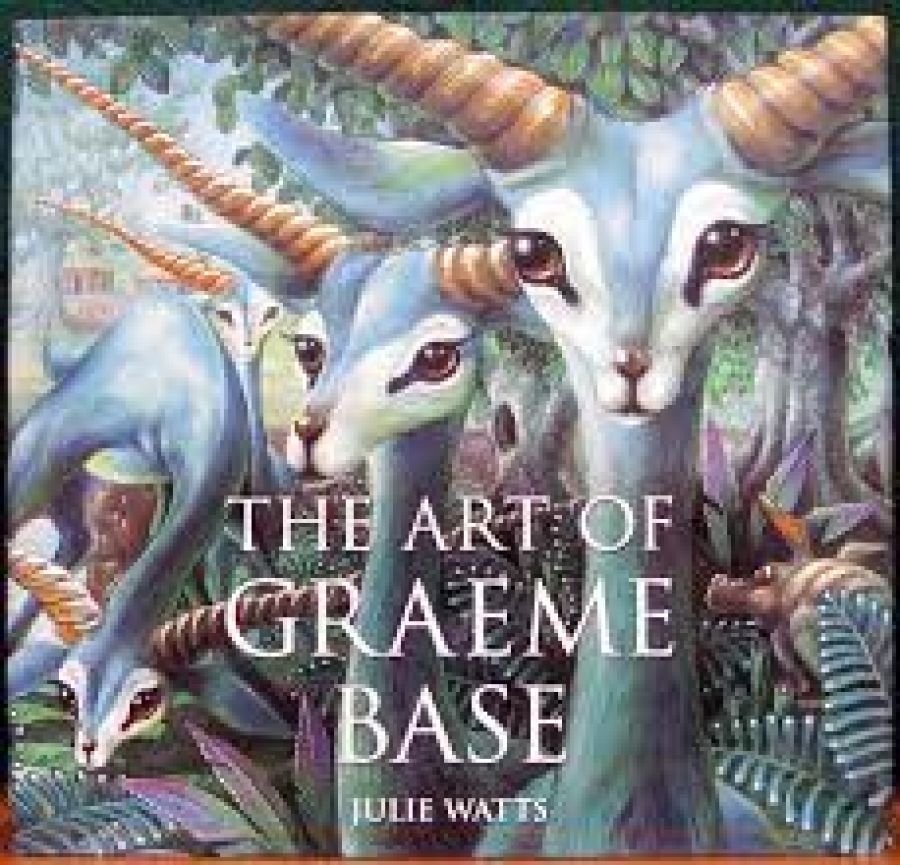
- Free Article: No
- Contents Category: Picture Books
- Review Article: Yes
- Article Title: Visually resplendent puzzles
- Online Only: No
- Custom Highlight Text:
When Graeme Base’s first picture book, My Grandma Lived in Gooligulch, was published in 1983, his exuberant illustrations and rollicking text produced a frisson. However, it was the incomparable ‘alphabet’ book Animalia (1986) that really launched Base’s career as a picture-book author–illustrator, and made him a publishing phenomenon in both Australia and the United States. In celebration of twenty-five years of Graeme Base picture books, his publisher, Penguin, has produced a glossy retrospective look at his work. Written by Julie Watts, a former editor and publisher at Penguin Books, The Art of Graeme Base is lavishly illustrated and engagingly written. The first chapter documents Base’s idyllic childhood in Britain and his migration to Australia with his family. The second charts his early adult life as a struggling graphic designer, aspiring rock star and budding illustrator. These chapters introduce the many talents, enthusiasms, influences and mentors that have shaped the Graeme Base ‘brand’. The next twelve chapters are devoted to in-depth revelations about the evolution and production of each of Base’s twelve books, including his most recent title, Enigma (2008). Many chapters also have a ‘Beyond the Book’ section, which explores the other formats that the indefatigable Base has ventured into as spin-offs from his books: television series, board books, dioramas, exhibitions and stage plays.
- Book 1 Title: The Art of Graeme Base
- Book 1 Biblio: Viking, $79.95 hb, 230 pp
As with all Base’s books, The Art of Graeme Base is stunningly designed. Interestingly, the arresting cover features the Grazing Gondalopes from Uno’s Garden (2006) rather than a more familiar image from one of his earlier books. However, the book design cleverly mirrors the size, format and title of The Art of Maurice Sendak (1980), by Selma G. Lanes, which was published by Base’s American publisher, Abrams. The implication is that Base is the Australian equivalent of Sendak. This is a big call, as there are many other Australian picture book author-illustrators who equally deserve this moniker: for example, Ron Brooks, Pamela Allen, Bob Graham, Shaun Tan and Jeannie Baker. However, Base is a significant player in this field for two reasons: the volume of his sales and his attendant ‘star’ status; and because he has created his own subgenre, the visually resplendent ‘puzzle’ picture book.
While the books on Sendak and Base are similar in design and layout, and in the way that they chronologically explore the life of their subject through his books, there is a significant difference. Lanes, a critic and reviewer, takes an analytical approach to her exploration of Sendak’s work, while Watts’s approach is more intimate and personal. At times, her enthusiasm is a little over the top and the writing strays into the realms of hagiography, but her inside knowledge of the man, his work and the publishing pro- cess provides insights that a more scholarly approach could not.
Base has written the captions for the multitude of sketches and full-page illustrations which accompany Watts’s text. He illuminates his creative processes, often with a cheeky twist that reflects the quirky sense of humour which flavours his books. However, what is most compelling about this book is the picture it paints of Graeme Base the man. Here is a gifted enthusiast who obviously inspires love and loyalty in those who work with him. He is also a lucky man, who has always been surrounded by inspirational people who have supported and encouraged him: his parents; his brother, Patrick; his English teacher and mentor, Max Garrard; his publisher, Bob Sessions; and his muse, sounding-board and soul mate, wife Robyn. The book also explores Base’s artistic influences, including surrealists, classicists, and the artistic and architectural styles that he has encountered on his many trips abroad.
In this personal journey through his life and books, including his ‘failures’ as well as his triumphs, Base emerges as an inspired and dedicated artist. Watts’s intimate story-telling style highlights Base’s whimsical nature, delight in wordplay, prodigious talent, attention to detail, obsession with design and production values, and capacity for sheer hard work. In the end, it is Base’s picture books which speak most eloquently about the man and his art, but The Art of Graeme Base provides a highly readable reference tool which will enable his fans to better appreciate his remarkable achievements.


Comments powered by CComment